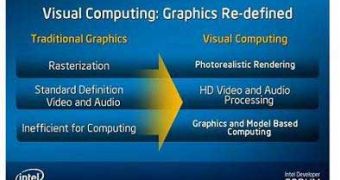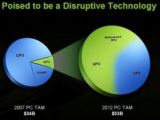Intel has finally allowed the world to take a look at what Larrabee is supposed to look like. The news spread fast, as expected, as the new technology has been said from the beginning to be innovative and lots of rumors have circled around it since its name first appeared on the web. The chip giant promises a lot with the "video computing" technology that will be made available next year. The recently disclosed details on Larrabee have caught the eye, and all that remains to be done is to have the actual product in our hands in order to see its capabilities.
In the meantime, we can sit back and reflect on what Larrabee promises and how much it can offer. Intel says that the technology is supposed to open new roads for developers, and that is the aspect it stresses on most. As all general purpose GPUs (GPGPUs) do, Larrabee is expected to be a starting point for a whole new wave of floating-point accelerated (visual computing) applications. This accelerator board will also work as a simple GPU, as it can handle games and visual entertainment content very easily.
In order to be a successful product, Larrabee needs to come with some specific features, and the most important one is the easiness it can offer when it comes to software development. Intel says that this part has already been covered, as the video computing technology is based on an x86 processor, and it can run C++ in the same manner an x86 CPU would. Of course, it will be able to do much more than that, but this is just the bottom line, and Intel puts this forward every time it has the chance.
But this is not enough to strike success. Larrabee has to do a little more in a market field which sees a tight competition between AMD and NVIDIA. The product needs to be a killer one, both in what concerns the performance levels it offers to consumers, as well as the ease to program for it. And to make things even more complicated, there are already GPGPUs and technologies that are meant to do the same as Larrabee. That is why some doubt that it will manage to penetrate the market the way Intel hopes.
When speaking about competing technologies, the first one to come to mind is NVIDIA's CUDA. As the green company says, this technology is just a set of C++ extensions that allows developers to make innovative programming. And there is enough time for the Santa Clara company to convince that its CUDA technology is highly capable before the first Larrabee sees the light. As a matter of fact, NVIDIA has already started teaching students and lecturers on its technology, and has also established developer relationships. This means that Intel will have some catching up to do.
Another essential aspect of the problem is the way Larrabee will appeal to consumers. Intel thought about it too, and announced that it would come with gaming and visual entertainment capabilities. But that won't be enough either, as both AMD and NVIDIA have on the market highly capable products and are on their way to develop and release some that will provide leveraged performance levels for gamers, multimedia enthusiasts and programmers as well.
Both Larrabee and CUDA have good and bad parts as well
When referring to competition, Intel displays a confident look. According to the company, NVIDIA's CUDA does not have the necessary flexibility required, and it is tightly connected to the GPU. That means that the simple C++ knowledge might not help if you know nothing about the hardware, like memory architecture, and that the power of the GPGPU won't be exploited to the full. According to TG Daily, some developers also believe that hardware knowledge is required to unleash the full capabilities of the card.
To prove that this is not how CUDA works, and that it can run on any multi-core platform, NVIDIA started to work on an x86 CUDA compiler. It looks like the company plans to have it launched as a beta by the end of the month, namely by the time Nvision opens its gates. If this works, the Santa Clara will prove that its technology is much more flexible than believed, and Larrabee will have to face a strong competitor.
CUDA might need hardware knowledge for successful programming and goes hand in hand with the GPU, but Larrabee has its tight corners, too. No doubt that it is capable of accelerating even applications that were not specifically programmed for it, but its complete potential needs something more to burst to surface. This refers to vector units, which means that it needs vectorization code. That is why developers seem skeptical when hearing about the ease of programming both NVIDIA and Intel keep talking about.
The evolution of Larrabee will be watched closely by developers, that?s for sure. Some of them believe that it won't be able to handle essential x86 capabilities. Intel said that it would be fully x86 capable, due to a small OS running on top of the architecture. And Larreabee should provide everything that the chip giant says, since CUDA is closing the x86 programming. And NVIDIA will work on that even more by the time Intel's visual computing technology comes.
The possibilities that GPGPU and cGPU computing are bringing to the industry are interesting enough and need to be treated as such. Developers seek to run and scale their applications in a multi-threaded environment that will not require understanding the hardware. That means the competition on the hardware area should be a fierce one. And since Intel and NVIDIA seem to be already engaged in the battle, we should be waiting for AMD's answer.

 14 DAY TRIAL //
14 DAY TRIAL // 
